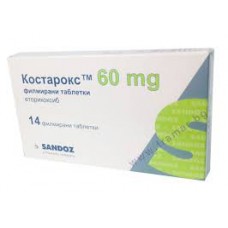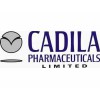Expiration date: 03/2026
Form of production, composition and packaging
Tablets, film-coated white color, round, lenticular
1 tab. contains - etoricoxib 90 mg
Auxiliary substances: calcium hydrophosphate anhydrous-39 mg, microcrystalline cellulose-38.25 mg, povidone K30-9 mg, magnesium stearate-1.5 mg, croscarmellose sodium-2.25 mg.
The composition of the shell tablets: Opadry II white 32K580000C 6 mg: hypromellose 15 cPs 2.4 mg lactose monohydrate 1.68 mg, titanium dioxide 1.44 mg, 0.48 triacetin mg.
Pharmacological action
NPVS. Selective inhibitor of COX-2, in therapeutic concentrations blocks the formation of prostaglandins and has anti-inflammatory, analgesic and antipyretic effect. Selective inhibition of COX-2 is accompanied by a decrease in the severity of clinical symptoms associated with inflammation, while there is no effect on the function of platelets and gastrointestinal mucosa.
Etoricoxib has a dose-dependent effect inhibiting COX-2 without effect on COX-1 when used in a daily dose to 150 mg has No effect on the production of prostaglandins in the gastric mucosa and bleeding time. In the conducted studies there was no decrease in the level of arachidonic acid and platelet aggregation caused by collagen.
Pharmacokinetics
After oral administration is rapidly absorbed from the gastrointestinal tract. Bioavailability when administered is about 100%. After taking adults on an empty stomach at a dose of 120 mg Cmax is 3.6 µg / ml, Tmax -1 h after administration. Food intake has no significant effect on the severity and rate of absorption etoricoxib when taken in a dose of 120 mg. however, the values of Cmax reduced by 36% and Mahooosive for 2 h. the geometric mean value of AUC0-24 compose 37.8 µg x h/ml. etoricoxib Pharmacokinetics within the therapeutic dose is linear.
Plasma protein binding exceeds 92%. Vd at steady state is approximately 120 L. Etoricoxib penetrates through the placenta and GEB.
Extensively metabolized in the liver, with the participation of isoenzymes of cytochrome P450 and the formation of 6-gidroksimetil-etoricoxib. Detected 5 metabolites etoricoxib, basic - 6-gidroksimetil-etoricoxib and its derivative 6-carboxy-acetyl-etoricoxib. The main metabolites do not affect COX-1 and are not active or inactive in relation to COX-2.
It is excreted by the kidneys as metabolites. Less than 1% is excreted in the urine unchanged.
With a single on/in the introduction of 70% excreted by the kidneys, 20% - through the intestine, mainly in the form of metabolites. Less than 2% found unchanged.
The equilibrium state is achieved after 7 days with a daily dose of 120 mg, with a cumulation coefficient of about 2, which corresponds to T1 / 2-about 22 no. plasma clearance is approximately 50 ml/min.
Patients with minor disorders of the liver (5-6 points on a scale child-Pugh) a single dose of etoricoxib at a dose of 60 mg/day was accompanied by an increase in AUC by 16% compared to healthy individuals.
In patients with moderate hepatic impairment (7-9 points on the child-Pugh scale) who took the drug at a dose of 60 mg every other day, the AUC value was the same as in healthy individuals who took the drug daily at the same dose.
Hemodialysis is significantly influenced by the elimination (dialysis clearance approximately 50 ml/min).
Indications
Symptomatic therapy of osteoarthritis, rheumatoid arthritis, ankylosing spondylitis; pain and symptoms of inflammation associated with acute gout arthritis; short-term treatment of pain associated with dental surgery.
Dosage regimen
The drug is taken orally at a dose of 60-120 mg 1 time / day.
In patients with liver failure (5-9 points on the child-Pugh scale) it is recommended not to exceed the daily dose of 60 mg.
Side effect
From the digestive system: often - epigastric pain, nausea, diarrhea, dyspepsia, flatulence; sometimes - bloating, belching, increased peristalsis, constipation, dryness of the mucous membrane of the mouth, gastritis, ulcers of the mucous membrane of the stomach or duodenal ulcers, irritable bowel syndrome, esophagitis, ulcers of the mucous membrane of the mouth, vomiting; very rarely - gastrointestinal ulcers (bleeding or perforation), hepatitis.
On the part of the nervous system: often-headache, dizziness, weakness; sometimes - a violation of taste, drowsiness, sleep disorders, sensitivity disorders, including paresthesia/hyperesthesia, anxiety, depression, concentration disorders; very rarely - hallucinations, confusion.
From the senses: sometimes-blurred vision, conjunctivitis, tinnitus, vertigo.
On the part of the urinary system: sometimes-proteinuria; very rarely-renal failure, usually reversible with the abolition of the drug.
Allergic reactions: very rarely-anaphylactic / anaphylactoid reactions, including marked decrease in blood PRESSURE and shock.
From the cardiovascular system: often-heartbeat, increased blood PRESSURE; sometimes-tides, cerebrovascular accident, atrial fibrillation, congestive heart failure, non - specific ECG changes, myocardial infarction; very rarely-hypertensive crisis.
From the respiratory system: sometimes-cough, shortness of breath, nose bleeding; very rarely - bronchospasm.
Dermatological reactions: often-ecchymosis; sometimes - swelling of the face, skin itching, rash; very rarely-urticaria, Stevens-Johnson syndrome, Lyell's syndrome.
Infectious complications: sometimes-gastroenteritis, infections of the upper respiratory tract, urinary tract.
From the musculoskeletal system: sometimes-muscle cramps, arthralgia, myalgia.
On the part of metabolism: often-swelling, fluid retention; sometimes-changes in appetite, weight gain.
From laboratory studies: often - increased activity of hepatic transaminases; sometimes-increased nitrogen in the blood and urine, increased activity of CPK, reducing hematocrit, hemoglobin reduction, hyperkalemia, leukopenia, thrombocytopenia, increased serum creatinine, increased uric acid; rarely - increased sodium in blood serum.
Other: often-flu-like syndrome; sometimes-pain in the chest.
Contraindications to use
Complete or incomplete combination of bronchial asthma, recurrent nasal polyposis or paranasal sinuses and intolerance to acetylsalicylic acid and other NSAIDs (including history).
Erosive and ulcerative changes in the mucous membrane of the stomach or duodenum, active gastrointestinal bleeding, cerebrovascular or other bleeding.
Inflammatory bowel disease (Crohn's disease, ulcerative colitis) in the acute phase.
Hemophilia and other blood clotting disorders.
Severe heart failure (II-IV functional classes according to NYHA classification).
Severe liver failure (more than 9 points on the child-Pugh scale) or active liver disease.
Severe renal failure (CC less than 30 ml / min), progressive kidney disease, confirmed hyperkalemia.
The period after the coronary artery bypass surgery; peripheral artery disease, cerebrovascular disease, clinically expressed IHD.
Stable arterial hypertension at blood PRESSURE values above 140/90 mm Hg. V.
Pregnancy, lactation (breastfeeding).
Children and adolescents up to 16 years.
Hypersensitivity to etoricoxib.
Use during pregnancy and breast-feeding
The drug is contraindicated in pregnancy and lactation. Etoricoxib can negatively affect female fertility and is not recommended for women planning pregnancy.
Application in violation of liver function
It is contraindicated in severe liver failure (more than 9 points on the child-Pugh scale) or active liver disease. In patients with moderate liver failure (5-9 points on the child-Pugh scale) it is recommended not to exceed the daily dose of 60 mg.
Use in renal impairment
Contraindicated in severe renal failure (QC less than 30 ml / min), progressive kidney disease.
Use in children
Contraindicated in children and adolescents under 16 years of age.
Use in elderly patients
Be used with caution in the elderly.
Special instruction
Use caution when specifying a history of ulcerative shock syndrome, infection of Helicobacter pylori, the elderly, in patients treated with NSAIDs long-term, severe somatic diseases, dyslipidemia/hyperlipidemia, diabetes, hypertension, edema and fluid retention, Smoking, in patients with KK less 60 ml/min, while concomitant therapy the following medications: anticoagulants (eg, warfarin), antiplatelet agents (e.g. acetylsalicylic acid, clopidogrel), corticosteroids (eg, prednisone), selective serotonin reuptake inhibitors (e.g., citalopram, fluoxetine, paroxetine, sertraline), in chronic alcoholism.
During treatment requires careful monitoring of blood pressure FOR the first 2 weeks and periodically in the future.
During treatment should be regularly monitored indicators of liver and kidney function. In the case of increased activity of hepatic transaminases 3 times or more relative to IGN, treatment should be discontinued.
Taking into account the increasing risk of adverse effects with increasing duration of administration, it is necessary to periodically assess the need for continued treatment and the possibility of reducing the dose.
Do not use in conjunction with other NSAIDs.
Impact on the ability to drive and operate machinery
During the period of treatment must be careful when driving and occupation of other potentially hazardous activities, require high concentration and psychomotor speed reactions. Patients who have had episodes of dizziness, drowsiness or weakness should refrain from classes that require concentration.
Drug interaction
Patients receiving warfarin reception etoricoxib at a dose of 120 mg/day was accompanied by an increase of approximately 13% MHO and prothrombin time. In patients receiving warfarin or similar medicines should monitor the performance of MHO during initiation of therapy or change the dosage regimen etoricoxib, especially in the first few days.
There are reports that non-selective NSAIDs and selective COG-2 inhibitors can reduce the hypotensive effect of ACE inhibitors. This interaction should be taken into account when treating patients receiving etoricoxib at the same time with ACE inhibitors. In patients with impaired renal function (for example, in dehydration or in the elderly), such a combination can exacerbate functional renal failure.
Etoricoxib can be applied simultaneously with acetylsalicylic acid in low doses used for prevention of cardiovascular diseases. However, coadministration of acetylsalicylic acid in low doses and etoricoxib can lead to an increase in the frequency of ulcerative lesions of the gastrointestinal tract and other complications compared to taking one etoricoxib. After reaching the equilibrium state of reception etorikoksib in a dose of 120 mg 1 time / day has no effect on the antiplatelet activity of acetylsalicylic acid in low doses (81 mg/day). The drug does not replace the preventive action of acetylsalicylic acid in cardiovascular diseases. Cyclosporine and tacrolimus increase the risk of nephrotoxicity in patients receiving etoricoxib.
There is evidence that non-selective NSAIDs and selective COG-2 inhibitors can increase the concentration of lithium in plasma. This interaction should be taken into account when treating patients receiving etoricoxib simultaneously with lithium.
There is evidence of increasing concentration of methotrexate in plasma by 28% (for AUC) and reduced renal clearance by 13% under the influence of etoricoxib.
Welcome etoricoxib at a dose of 120 mg oral contraceptives containing 35 mcg of ethinyl estradiol and 0.5 to 1 mg norethindrone within 21 days, simultaneously or with a difference in 12 hours increases inpatient AUC0-24 of ethinyl estradiol by 50-60%. However, the concentration of norethisterone usually does not increase to a clinically significant degree. This increase in the concentration of ethinyl estradiol should be taken into account when selecting an appropriate oral contraceptive for simultaneous application of etoricoxib. Such a fact can lead to an increase in the frequency of thromboembolism, by increasing the exposure of ethinyl estradiol.
Etoricoxib not affect the AUC0-24 at steady state or the elimination of digoxin. However, it increases Cmax (by an average of 33%), which may be important in the development of digoxin overdose.
Simultaneous reception etoricoxib and rifampicin (potent inducer of hepatic metabolism) leads to a decrease of 65% etoricoxib AUC in plasma. This interaction should be considered when concomitant administration with rifampicin etoricoxib.
The description of active substances of the drug is presented.The given scientific information is generalizing and can not be used to make a decision about the possibility of using a particular drug.
There are contraindications, consult your doctor.




